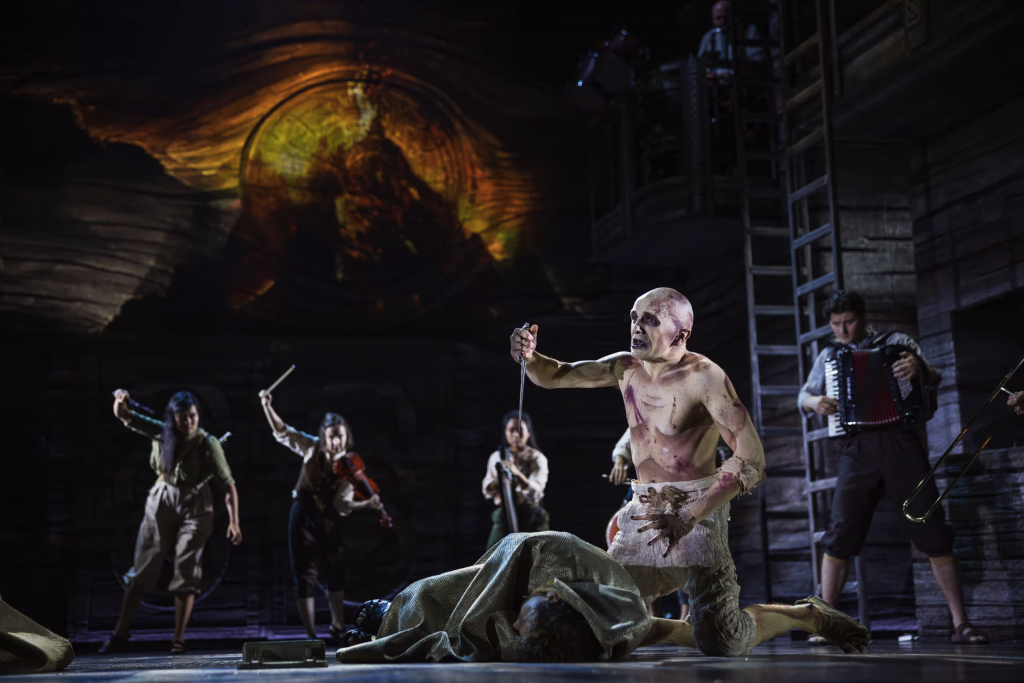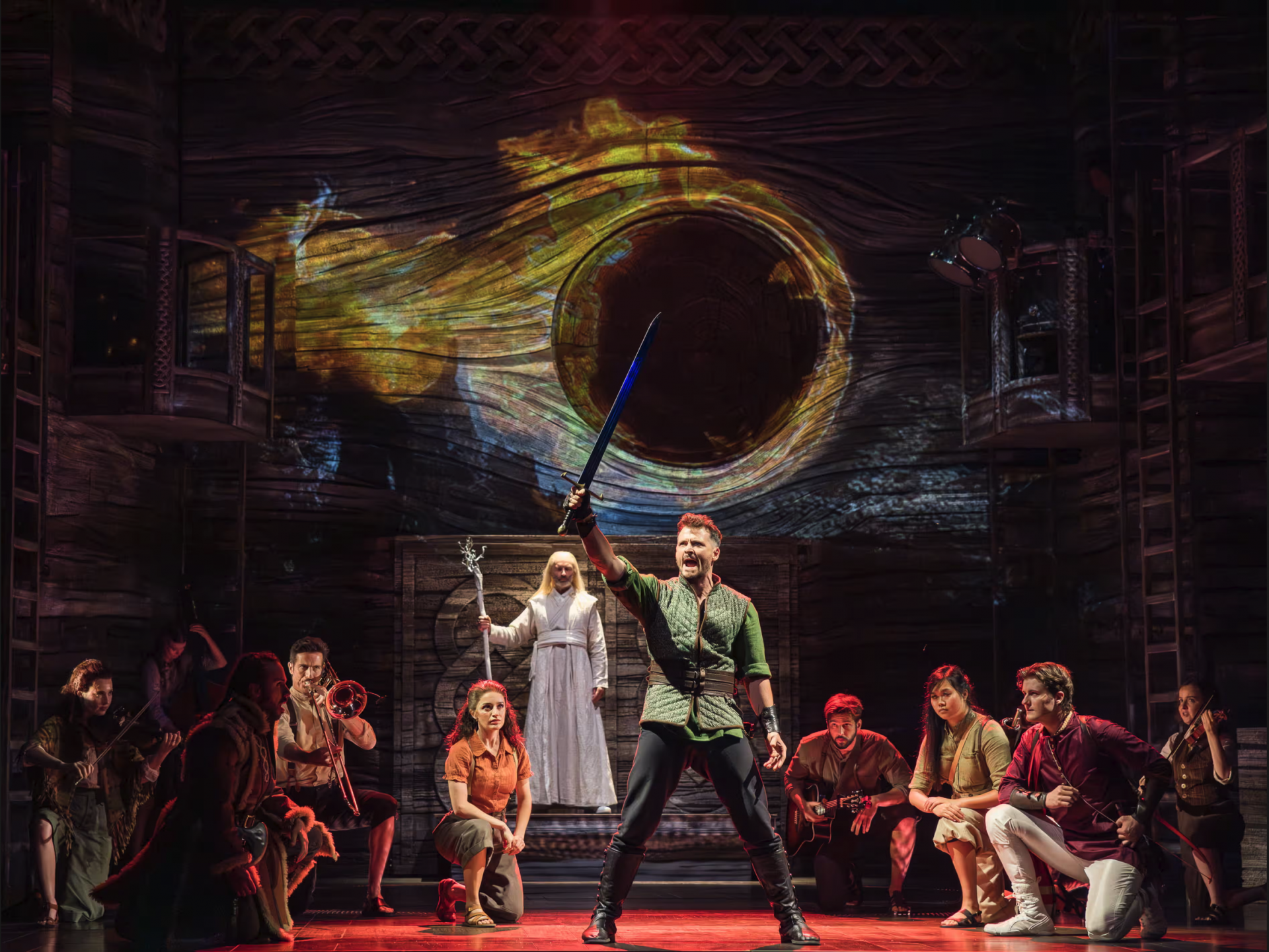If there’s one musical to rule them all, it’s this one.
The Lord Of The Rings – A Musical Tale has landed with a bang at Sydney’s State Theatre. Given the seal of authority from Middle-earth Enterprises LLC – the official company managing all things The Lord Of The Rings – it tells the classic tale of Frodo Baggins and his quest to save Middle Earth by destroying the Ring of Power. Despite some narrative and pacing flaws, it brings Peter Jackson’s films and J.R.R. Tolkien’s books to the stage with plenty of whimsy and delight.
The Lord Of The Rings – A Musical Tale condenses its source material – the 558-minute film trilogy and 1,077-page six-book saga – into three hours of runtime. The first act covers the events of the first film, The Fellowship Of The Ring. The second act squeezes the remaining films, The Two Towers and The Return Of The King, into just over an hour. Elements of the books are incorporated into each act.
Musically and visually, the show is fantastic. The music and orchestration, courtesy A.R. Rahman, Värttinä, and Christopher Nightingale, exude the playfulness, joy and mystique of Middle Earth’s fantastical medieval land. Flutes, drums, harps, xylophones and more (played on stage by the ensemble cast) provide a wondrous aural soundscape to the places Frodo visits, from the dense green village of Hobbiton to the elf-populated Lothlórien to the treacherous and volcanic Mount Doom. These places are brought brilliantly to life through projection design by George Reeve. Costumes are also colourful, flashy and film-accurate. Also notable are the show’s puppets. Designed by Charlie Tymms and operated by a collection of dark-clothed, black-masked ensemble members, they depict the Nazgûl, a legion of evil undead horseriders, and Shelob, a giant spider. Intricately designed and (in the case of Shelob) surprisingly large, they move coldly and menacingly and are stand-out features of each act.

The song and dance numbers fulfil their limited role. They do well to bring energy to a scene that needs it, such as the 111th (“eleventy-first”) birthday of Frodo’s uncle Bilbo or a crowded tavern Frodo and his friends find themselves in. The lyrics and choreography are entertaining although a little basic, often relying more on grand vocal performances and frenetic pace in place of good song writing or skilful movement. Some numbers could be cut for time, most obviously a tacky second act duet between warrior ranger Strider (Rob Mallett) and his elf love interest Arwen (Stefanie Caccamo).
However, there are also moments where the song and dance stand out. The breakdancing-inspired choreography of the villainous orcs (courtesy choreographers Anjali Mehra, Laura Savage and Nicholas Cunningham) is dynamic and funky. A duet about friendship by Frodo (Rarmian Newton) and his compatriot Samwise Gamgee (Wern Mak) is performed with beautiful warmth and emotion. Jemma Rix as the royal elf Galadriel nails her many songs with flair and passion. Additionally, it is also fun to interact with the cast, who occasionally run between the aisles of the State Theatre during a scene.
Most importantly, the story of The Lord Of The Rings is told well. Director Paul Hart has simplified the source material in a way that makes the plot easy to follow. Some diehard fans may be upset over what is left out, but the films and books still exist. The cast overcome their lacklustre start to embody their characters successfully. Lead actors Newton and Mak as Frodo and Sam are initially too reserved but become more confident as the performance goes on. Most of the supporting cast, such as dwarf Gimli (Connor Morel) and comic relief Merry (Jeremi Campese) and Pippin (Hannah Buckley), are given little to do at the beginning but put on more compelling performances as their importance grows. Exceptions to this are Terence Crawford as the wizard Gandalf, Ian Stenlake as another wizard Saruman, and Laurence Boxhall as the monster Gollum. Crawford and Stenlake immediately portray their characters with a combination of authority, sophistication, and humanity, capturing the aura of Sir Ian McKellen and Christopher Lee perfectly. Gandalf’s death while fighting a mythical being in the first act is an especially captivating moment, with projections of fire, a writhing black tarp controlled by the ensemble, and an emotional performance from Crawford.

Contrasting Crawford and Stenlake’s elegance, Boxhall’s Gollum is utterly bizarre. On stage Boxhall is unrecognisable, performing bare-chested, scarred, and bald. He writhes around the space like a leech, reciting his dialogue in the annoying nasal voice Gollum is known for. He sings musical numbers in this voice, which should not work, yet somehow does. He creates a Gollum that is unhinged, unpredictable, and utterly spellbinding. The climax of his character’s arc is one of the show’s most enjoyable moments. Just like his film equivalent, Boxhall leaves a mark which will be hard to forget.
Overall, The Lord Of The Rings – A Musical Tale is riveting. Die-hard The Lord Of The Rings fans may feel like the show missed things. Die-hard musical fans may want more songs. But the production stays faithful to its source material while adding elements that more often enhance, rather than detract, from the core tenets of the franchise. It shall not pass – it’s better than that.
This article first appeared on Scenestr.
